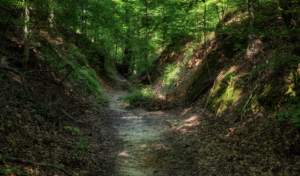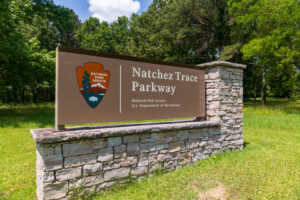The Bynum Mounds
The Bynum archaeological site, MCS-16, is a significant archaeological area located on a 15-acre tract in Chickasaw County, Mississippi. Purchased by the State of Mississippi Highway Commission from local farmer “Uncle Joe” Bynum, this site lies three miles east of Houston, adjacent to Houlka Creek, a tributary of the Tombigbee River (Cotter & Corbett, 1951). Positioned at the southern end of the Pontotoc Ridge, the Bynum site serves as a natural divide between the drainage basins of the Tombigbee River to the east and those of the Pearl and Big Black Rivers to the west. It sits at milepost 232.4 on the Natchez Trace. This ridge is characterized by red sandy loam soils, formed through the weathering of glauconitic sandy marl and limestone formations (Cotter & Corbett, 1951). It hosts a series of mounds accompanied by a village site.

Ecological Characteristics
The climate of northern Mississippi features a mean annual temperature of 62.4°F and substantial rainfall averaging 50 inches per year (Cotter & Corbett, 1951). This climate supports a long growing season, conducive to a diverse array of vegetation. Historically, the region’s flora consisted of hardwood forests, pine forests, and grasslands, creating a rich habitat for wildlife.
Excavation
 Excavation began “10 to 25 feet” from the mound’s basal edge, assessing undisturbed earth for post-mold patterns (Cotter & Corbett, 1951). As features were uncovered, efforts were made to preserve them from damage. In Mound B, successive profiles were cut to reveal an interior sub-mound feature, while Mound A utilized an existing central clearing to open the mound fully.
Excavation began “10 to 25 feet” from the mound’s basal edge, assessing undisturbed earth for post-mold patterns (Cotter & Corbett, 1951). As features were uncovered, efforts were made to preserve them from damage. In Mound B, successive profiles were cut to reveal an interior sub-mound feature, while Mound A utilized an existing central clearing to open the mound fully.
The excavation employed 5-foot grids on mound surfaces and 10-foot grids in the village area. Features and burial locations were documented using tools like alidade, tape, and plane tables. A comprehensive photographic record was maintained, including over 400 Kodachrome and 300 black-and-white images (Cotter & Corbett, 1951). Specimens collected in the field were serialized and cataloged, with notations about their provenience, ensuring a systematic approach to data management.

Analysis of animal remains from the site indicates that deer were the predominant game species, accounting for 85% of identified nonhuman bones (Cotter & Corbett, 1951). Other species, such as raccoon and fox, were present in lesser amounts. Despite a lack of preserved small bones, it is suggested that a diverse array of game animals thrived in the area during prehistoric times. Excavations at the Bynum site were meticulously planned, utilizing a structured grid system. The site was divided into a “100-foot grid”, allowing precise recording of features and artifacts, with hub stakes marking intersections to create detailed contour maps of the mounds (Cotter & Corbett, 1951).
Archaeological Findings
Approximately seven acres of the Bynum site retain original topsoil, making them suitable for archaeological testing, but over a century of agricultural activity has eroded 2 to 3 feet of topsoil, potentially destroying significant cultural deposits (Cotter & Corbett, 1951). The site has yielded a wealth of cultural artifacts, including 13,729 sherds, predominantly plain, fabric-impressed, or cordmarked, with some suggesting trade connections with other regions (Cotter & Corbett, 1951). Despite variations in paste, temper, and composition among the sherds, they were not distinct enough to establish new types, and no complete pottery vessels were found, though reconstructions from rim sherds were attempted.

During the Woodland Period, Baldwin Plain pottery exemplified the ceramic technology and cultural practices of its makers in Mississippi. Characterized by a dark coloration ranging from dark gray to black, derived from firing processes and clay composition, Baldwin Plain pottery featured a smooth, polished surface indicative of careful finishing techniques.
Unlike contemporaneous styles with elaborate designs, Baldwin Plain pottery focused on functionality, offering vessels like bowls and jars primarily for storage, cooking, or serving purposes. The clay often included tempering agents such as grit or shell fragments, enhancing durability (“Woodland Period,” Mississippi Encyclopedia). Sherds from Bynum, classified as Baldwin Plain due to their plain sand-tempered composition, feature a fine, compact texture with a gritty feel, where sand grains can be dislodged with slight pressure.

The predominant dark red or reddish-brown coloration, coupled with smoothed interiors often showing faint striations near the rim, further typifies these artifacts (Cotter & Corbett, 1951). Baldwin Plain pottery thus stands as a testament to the advanced craftsmanship and skill of Indigenous communities during the Woodland Period in the Mississippi region(“Woodland Period,” Mississippi Encyclopedia).
The Bynum site is a vital archaeological location that offers deep insights into northeastern Mississippi’s cultural and ecological history. Through thorough excavation methodologies and systematic data collection, researchers continue to unravel the significance of this remarkable site, revealing the complex tapestry of human habitation and activity throughout prehistoric times.
Go Visit! The Bynum site is open to the public. Get more info here.
Citations:
Cotter, J. L., & Corbett, J. M. (1975). Archaeology of the Bynum Mounds, Mississippi. Mississippi Department of Archives and History. Retrieved from https://play.google.com/books/reader?id=nHKrDcHZGB8C&pg=GBS.PP2&hl=en
“Woodland Period.” Mississippi Encyclopedia. Accessed July 20, 2024. https://mississippiencyclopedia.org/entries/woodland-period/
Photos Courtesy of Adobe Stock and Archaeology of the Bynum Mounds, Mississippi written by J.L. Cotter and J.M. Corbett.
Read the previous article here!
Echoes of the Mississippi: The Woodland Period in Mississippi



















